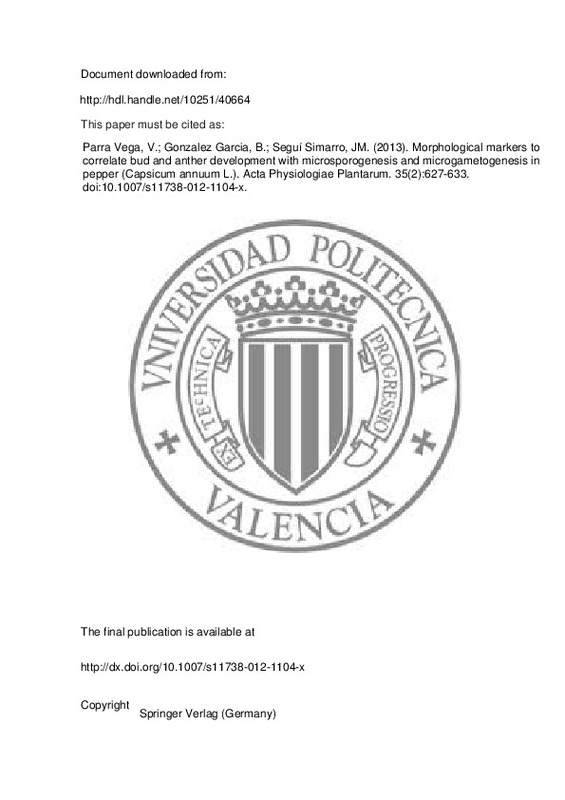Barany I, Gonzalez-Melendi P, Fadón B, Mityko J, Risueño MC, Testillano PS (2005) Microspore-derived embryogenesis in pepper (Capsicum annuum L.): subcellular rearrangements through development. Biol Cell 97:709–722
Barany I, Fadon B, Risueno MC, Testillano PS (2010) Cell wall components and pectin esterification levels as markers of proliferation and differentiation events during pollen development and pollen embryogenesis in Capsicum annuum L. J Exp Bot 61:1159–1175. doi: 10.1093/jxb/erp392
Buyukalaca S, Comlekcioglu N, Abak K, Ekbic E, Kilic N (2004) Effects of silver nitrate and donor plant growing conditions on production of pepper (Capsicum annuum L.) haploid embryos via anther culture. Eur J Hortic Sci 69(5):206–209
[+]
Barany I, Gonzalez-Melendi P, Fadón B, Mityko J, Risueño MC, Testillano PS (2005) Microspore-derived embryogenesis in pepper (Capsicum annuum L.): subcellular rearrangements through development. Biol Cell 97:709–722
Barany I, Fadon B, Risueno MC, Testillano PS (2010) Cell wall components and pectin esterification levels as markers of proliferation and differentiation events during pollen development and pollen embryogenesis in Capsicum annuum L. J Exp Bot 61:1159–1175. doi: 10.1093/jxb/erp392
Buyukalaca S, Comlekcioglu N, Abak K, Ekbic E, Kilic N (2004) Effects of silver nitrate and donor plant growing conditions on production of pepper (Capsicum annuum L.) haploid embryos via anther culture. Eur J Hortic Sci 69(5):206–209
Dumas de Vaulx R, Chambonnet D, Pochard E (1981) Culture in vitro d’anthères de piment (Capsicum annuum L.): amèlioration des taux d’obtenction de plantes chez différents génotypes par des traitments à +35 °C. Agronomie 1 (10):859-864
Dunwell JM (2010) Haploids in flowering plants: origins and exploitation. Plant Biotechnol J 8(4):377–424. doi: 10.1111/j.1467-7652.2009.00498.x
Ercan N, Sensoy FA, Sirri Sensoy A (2006) Influence of growing season and donor plant age on anther culture response of some pepper cultivars (Capsicum annuum L.). Sci Hort 110(1):16–20
Irikova T, Grozeva S, Rodeva V (2011) Anther culture in pepper (Capsicum annuum L.) in vitro. Acta Physiol Plant 33(5):1559–1570. doi: 10.1007/s11738-011-0736-6
Kim M, Kim J, Yoon M, Choi DI, Lee KM (2004) Origin of multicellular pollen and pollen embryos in cultured anthers of pepper (Capsicum annuum). Plant Cell, Tissue Organ Cult 77:63–72
Kim M, Jang IC, Kim JA, Park EJ, Yoon M, Lee Y (2008) Embryogenesis and plant regeneration of hot pepper (Capsicum annuum L.) through isolated microspore culture. Plant Cell Rep 27(3):425–434
Koleva-Gudeva LR, Spasenoski M, Trajkova F (2007) Somatic embryogenesis in pepper anther culture: the effect of incubation treatments and different media. Sci Hort 111(2):114–119
Lantos C, Juhász A, Somogyi G, Ötvös K, Vági P, Mihály R, Kristóf Z, Somogyi N, Pauk J (2009) Improvement of isolated microspore culture of pepper (Capsicum annuum L.) via co-culture with ovary tissues of pepper or wheat. Plant Cell Tiss Org Cult 97(3):285–293. doi: 10.1007/s11240-009-9527-9
Ltifi A, Wenzel G (1994) Anther culture of hot and sweet pepper (Capsicum annuum L.): influence of genotype and plant growth temperature. Capsicum Eggplant Newsl 13:74–77
Mityko J, Andrasfalvy A, Csillery G, Fari M (1995) Anther culture response in different genotypes and F1 hybrids of pepper (Capsicum Annuum L). Plant Breed 114(1):78–80
Nowaczyk P, Kisiala A (2006) Effect of selected factors on the effectiveness of Capsicum annuum L. anther culture. J Appl Genet 47(2):113–117
Regner F (1996) Anther and microspore culture in Capsicum. In: Jain SM, Sopory SK, Veilleux RE (eds) In vitro haploid production in higher plants, vol 3. Kluwer, Dordrecht, pp 77–89
Regnet F (1994) Microspore culture of Capsicum annuum. Capsicum Eggplant Newsl 13(1114):69–70
Salas P, Rivas-Sendra A, Prohens J, Seguí-Simarro JM (2012) Influence of the stage for anther excision and heterostyly in embryogenesis induction from eggplant anther cultures. Euphytica 184(2):235–250. doi: 10.1007/s10681-011-0569-9
Seguí-Simarro JM (2010) Androgenesis revisited. Bot Rev 76(3):377–404. doi: 10.1007/s12229-010-9056-6
Seguí-Simarro JM, Nuez F (2005) Meiotic metaphase I to telophase II is the most responsive stage of microspore development for induction of androgenesis in tomato (Solanum lycopersicum). Acta Physiol Plant 27(4B):675–685
Seguí-Simarro JM, Corral-Martínez P, Parra-Vega V, González-García B (2011) Androgenesis in recalcitrant solanaceous crops. Plant Cell Rep 30(5):765–778. doi: 10.1007/s00299-010-0984-8
Shivanna KR (2003) Pollen biology and biotechnology. Science Publishers Inc., Enfield
Supena EDJ, Muswita W, Suharsono S, Custers JBM (2006a) Evaluation of crucial factors for implementing shed-microspore culture of Indonesian hot pepper (Capsicum annuum L.) cultivars. Sci Hort 107(3):226–232
Supena EDJ, Suharsono S, Jacobsen E, Custers JBM (2006b) Successful development of a shed-microspore culture protocol for doubled haploid production in Indonesian hot pepper (Capsicum annuum L.). Plant Cell Rep 25(1):1–10
[-]







![[Cerrado]](/themes/UPV/images/candado.png)


